Magnetization and demagnetization – two sides of the same coin.
This document explains how these two processes are linked and how the magnetisation and demagnetisation of iron and steel, as well as of ferromagnetic metals works in general.
This knowledge is a prerequisite for making the decision regarding the correct demagnetisation device or the correct demagnetisation machine. Because this is the only way to guarantee that workpieces are free of magnetism or residual magnetism, and therefore also that production and the product do not suffer any loss of quality.
Magnetising and demagnetising magnetic materials
When a ferromagnetic material, such as iron or steel, is exposed to an external magnetic field, the material becomes magnetised.
What happens inside a ferromagnetic material during magnetisation? The external magnetic field (H field) aligns the elementary magnets inside a material.
The elementary magnets in ferromagnetic materials are not arranged freely inside the material, but rather are grouped in domains.
These domains (also known as Weiss domains) are separated from each other by domain walls. The size of the domains is generally below 100 µm (for non-magnetised materials), the thickness of the domain walls is only a few hundred inter-atomic distances.

The domain walls are moved in the material as the external magnetic field increases and due to the magnetic flow (B field) connected with this. However, this induced magnetic flow does not increase evenly, but rather in small, non-continuous jumps known as Barkhausen jumps. As the magnetic field grows, increasingly large domains are therefore formed with the corresponding regular alignment of the elementary magnets. In the ideal scenario of magnetic saturation, one single large domain with magnetically anchored elementary magnets is formed. Ferromagnetic materials retain a higher or lower magnetism after magnetisation, which is also known as residual magnetism or remanence.
Demagnetisation is achieved by using the alternating magnetic field to move the evenly aligned elementary magnets into homogeneous disorder and to generate as fine a domain structure as possible. The demagnetisation power that must be applied for this is defined by the field strength. This depends on the current, the coil opening, the coil length and the number of coils.
Demagnetisation is successful if the demagnetisation pulse is designed so that the polarity of all elementary magnets, including those inside the material, is reversed in one direction after the maximum required field strength is reached. When reducing the field strength subsequently, the elementary magnets are first homogenised.
A fine domain structure is generated by the frequency’s shaking effect. This first occurs inside the component. However, the polarity of the elementary magnets in the outermost area and on the surface continues to be reversed until the applied demagnetisation field decays completely. The component is therefore demagnetised from inside to out.
Slightly magnetised components that first show moved domain walls in the material, but in which the elementary magnets have not yet anchored, can be processed with a smaller demagnetising field than fully magnetised materials.
Which methods can be used for demagnetisation?
Once a ferromagnetic material has magnetised, this magnetisation theoretically remains for an unlimited time.
A magnetic material can be demagnetised using the following methods:
- Heating the product to above the Curie temperature.
- Strong vibrations (hammer blows) that can cause a slight reduction in magnetisation due to their own magnetic field.
- Demagnetisation using an externally applied, alternating decreasing magnetic field.
- Moving the magnetic field by applying a magnetic field with the opposite polarity beyond the polarity reversal with subsequent stopping of the field source. The magnetism in the component jumps to virtually the zero point if the field setting is metered exactly. This method is known as knockdown demagnetisation.
Supposedly non-magnetic stainless steels
Some steel types are considered non-magnetic. However, this is not always the case and frequently causes confusion. Especially with stainless steel, the material designation alone is not sufficient to be able to determine the magnetic properties. The bandwidth within the material class can be magnetic and non-magnetic. The magnetic properties depend on the structure inside the steel. Differentiation is made between the following structures:
The magnet test can be used to easily determine whether a steel is magnetic or not: If a magnet sticks, it is ferritic or martensitic. Austenitic stainless steels are generally not magnetic. However, the structure of austenitic steel can change when forming and become martensitic. An annealing process is the only way to change the martensitic structure back into an austenitic structure, but only if the component also enables this.
Do I also obtain non-magnetic stainless steel by demagnetising?
No, demagnetisation does not change the physical properties. The structure remains martensitic (μr > 1) and can be re-magnetised. You do not obtain non-magnetic, austenitic stainless steel by demagnetising steel. Demagnetising simply removes any magnetisation present in the material.
How demagnetising is performed in practice
In practice, a system that works with an alternating decreasing magnetic field is used for a demagnetisation system.
An alternating decreasing magnetic field can be generated in two ways in principle:
- Demagnetisation by increasing the distance
The component to be demagnetised is generally pulled through a demagnetisation tunnel at a moderate, even speed or over a plate or yoke demagnetiser. During this process the alternating magnetic field becomes ever weaker due to the increasing distance between the component and the source of the magnetic field. The demagnetisation power depends here on the generated field strength, whereas the penetration depth is determined by the alternating magnetic field frequency. The speed at which the component can be moved away from the alternating field also depends on the frequency. It is important that the component is still subjected to sufficient vibrations while the alternating field decreases.
- Demagnetisation via a demagnetisation pulse
The second variant is static demagnetisation using a demagnetisation pulse. The component is not moved during this process, but a control unit uses current to control the alternating magnetic field. The alternating magnetic field is first increased to the maximum field strength and then monotonically reduced to a zero field.
Benefits of pulse demagnetisation
Demagnetisation using a pulse is currently “state of the art”
In order to understand the benefits of demagnetising using a pulse, it is first helpful to observe the most important physical properties using an air coil. Cyclical demagnetisation is another positive factor that is in favour of pulse demagnetisation.
The relevant physical properties for each coil
A copper or aluminium coil is generally operated with mains voltage (110 V–480 V) and the corresponding mains frequency of 50/60 Hz. The coil’s heat balance is set to around 80°C by the coil’s inductiveness and resistance. In order to prevent overheating, the magnetic field strength is extremely limited for physical reasons, as the current must be limited. During pulse magnetisation, the maximum current is only held for a fraction of a second and then reduces within a few seconds.
Benefits of pulse demagnetisation compared to cyclical demagnetisation
- Depending on the heat, the low field strength can prevent the elementary magnets in a component from all being aligned at the maximum field strength. This results in the elementary magnets that could not be aligned causing increased residual magnetism. Reducing the frequency can optimise the penetration depth. Frequency converters are generally used for this in order to change the mains connection’s frequency. In pulse magnetisation, the field strength can be multiplied several times over due to the short switch-on duration. Thanks to the controlled cycle time and a maximum current duration of a few hundredths of a second, coil overheating does not occur. The much higher magnetic field strengths caused by this guarantee complete and reliable demagnetisation even inside the material if configured correctly.
- Thanks to pulse demagnetisation, in particular with the Maurer Degaussing® technology, large assemblies can be demagnetised. For example, demagnetising cutting dies without having to dismantle them saves time and prevents losing the settings. The powerful systems can also be used to demagnetise washing baskets filled completely with bulk goods in just a few seconds. This results in very high demagnetisation system productivity.
- Pulse demagnetisation is extremely reliable, as the pulse sequence can be checked for its specified properties. An optimum result can be expected if the position of the components remains the same. Reliable, zero-error demagnetisation is achievable with pulse demagnetisation.
Maurer Magnetic pulse demagnetisation
Controlled process with zero errors and high productivity
Demagnetisation with the Maurer Degaussing® technology provides you with decisive benefits compared to conventional demagnetisation systems:
High field strength
The field strength is one of the most important process parameters for demagnetisation. It is sufficient if the maximum field strength is generated for a short time and for the duration of at least one complete sine wave. The maximum alternating current that normally flows through a copper coil is limited physically by the inductive and ohmic resistance. In order to enable as large an effective current as possible to flow despite these resistances, the machines with Maurer Degaussing® technology are operated with a multiple of the mains voltage used.
Precise decreasing alternating field
If the maximum field strength is reached, the demagnetisation pulse must abate precisely and monotonically. The precision with which the current decreases has a direct effect on the demagnetising result. Even the smallest irregularities impede the random and homogeneous distribution of the magnetic structure in the component.
Perfect field symmetry in the discharge
In the pulse’s final phase, even the smallest symmetrical deviation between the north and south poles of the field strength acting on the component causes residual magnetism. A symmetrical deviation can also be caused by an induced external magnetic field, typically, the earth’s magnetic field. Therefore, the residual magnetism is not just caused by the precision of the demagnetisation pulse. This effect occurs mainly on long stretched parts and bulk goods.
Thanks to measures such as magnetically shielding components from the earth’s magnetic field when demagnetising, it is possible to significantly improve the results achieved on bulk goods or long stretched components. This unique measure is protected by a Maurer Magnetic patent.
Ideal demagnetisation frequency
Deep frequencies enable a better penetration depth in the material, as this can overcome the material inertia and prevent eddy current blockages in the material. However, high frequencies are beneficial for fine domain structures. This contradiction is to be used to find a compromise according to the component’s volume, in order to be able to obtain an optimum result.
In order to overcome the supposed incompatibility, Maurer Magnetic uses highly magnetic demagnetisation field strengths in its machines. This is the only way to overcome the resistances inside the material by magnetic saturation. The high frequencies used in this way increase the cost-effectiveness of our technology enormously.
We determine the ideal composition of the demagnetisation sequence in preliminary tests.
Typical frequencies are:
- 50–200 Hz fast-running belt material and wires
- 16–50 Hz baskets with bulk goods, small components
- 8–16 Hz medium-sized parts
- 4–8 Hz large components
- 1–4 Hz very large and bulky parts
A combination of multiple frequencies is also possible.
High field strengths at high frequencies are no problem thanks to the Maurer Degaussing® procedure. The procedure enables high field strengths even at high frequencies, typically 15–50 Hz. For perfect demagnetisation and high productivity, as already stated, high frequencies are beneficial. The demagnetisation frequency is set up in the factory for the component and the required cycle time.
Very large and bulky parts are demagnetised using a specially-developed universal pulse that works with a very wide frequency band.
Pure active power
The inductiveness (a coil operated with AC voltage) in operation generates unwanted reactive current and reactive power that strains the mains unnecessarily and results in costs. The Maurer Degaussing® procedure compensates for this reactive power completely and consumes only active power.
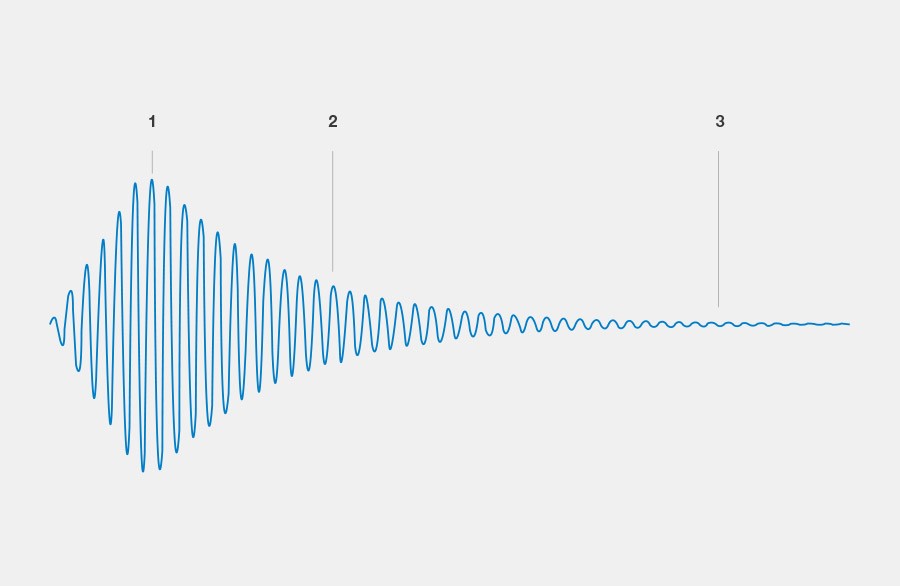
With the Maurer Degaussing® technology, Maurer Magnetic has fully utilised all physical options for economical, efficient and holistic demagnetisation.
This technology cannot just obtain demagnetisation to below the earth’s magnetic field. The technology also guarantees process reliability, is enormously productive and particularly energy saving.
Surrounding demagnetisation field
During demagnetisation, the component is ideally surrounded by as homogeneous a demagnetisation field as possible. For this reason, we generally use demagnetisation coils and no yoke for our systems.
Comparison of different demagnetisation systems
The different demagnetisation systems with their strengths and weaknesses
Demagnetising using a cyclical tunnel coil
A tunnel coil (air coil) is a simple demagnetiser that is normally operated directly on the mains at 50/60 hertz. The decreasing alternating field is achieved by increasing the distance, i.e. the component must be moved evenly through the coil. The area beyond the coil is known as the discharge area. Depending on the component’s geometry and the coil opening, the discharge area is around three to six times the size of the coil width.
Advantages
- economical and robust
- high throughput
- symmetrical, homogeneous demagnetisation field
Disadvantages
- a long discharge section is required
- weak to moderate field strength (<30 kA/m)
- demagnetisation effect depends on the component’s movement and shape
- high reactive power and poor efficiency
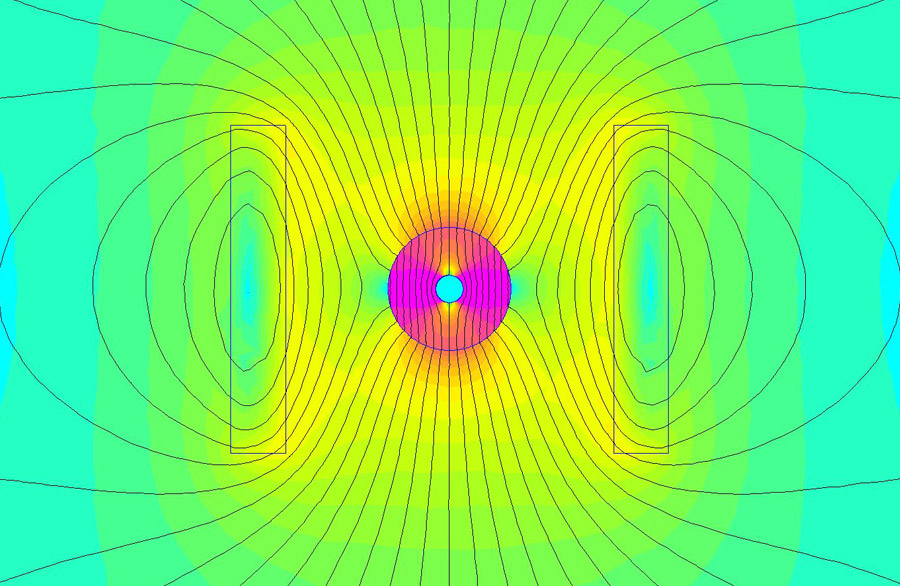
Demagnetising using a plate demagnetiserin continuous operation
A plate demagnetiser works with an interior coil with an iron core or a yoke. The magnetic flow is guided via the yoke to pole plates and consolidated in the air gap between the two pole plates. Therefore, very high field strengths can be obtained in the narrow air gap effective range but the effective depth is highly limited at just a few millimetres, which is why the procedure is only suitable for thin components. As with a tunnel coil, the decreasing alternating field is generally generated by movement or increasing the distance to the pole plate.
Advantages
- simple design
- high field strength close to the pole plates (approx. 100 to >160 kA/m) due to the flow concentration
- high throughput
Disadvantages
- inhomogeneous field and therefore great effect on the component’s position and its size
- demagnetisation effect depends on the component’s movement
- typically, flat components
- typical penetration depth < 10 to 15 mm
- sometimes no one hundred percent switch-on duration
- if operated manually, the field exposure is often above the permissible limit value.
- sensitive or polished components may get scratched
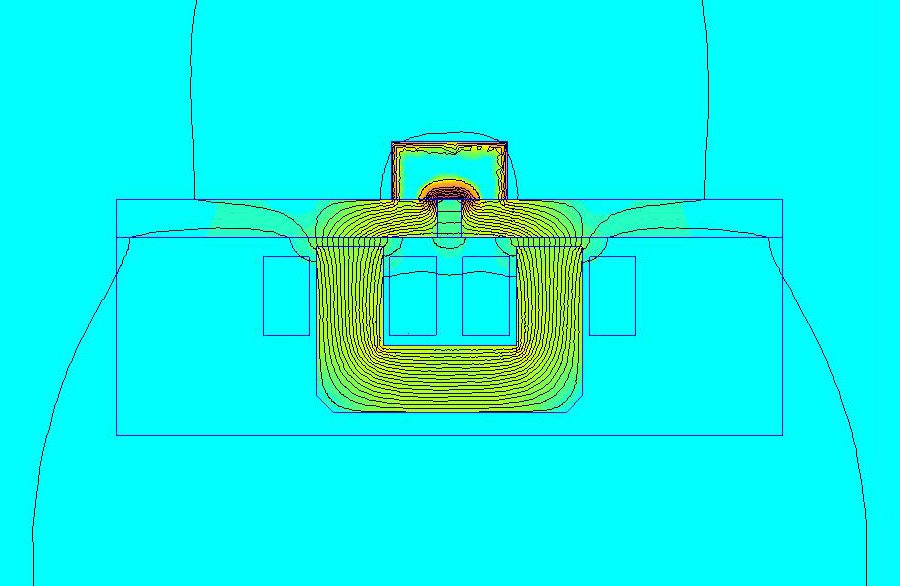
Demagnetising using a yoke demagnetiser
A yoke demagnetiser is basically built in the same way as a plate demagnetiser but without the pole plates. The magnetic flow is less concentrated, which causes a greater stray flux. The field strength is correspondingly lower.
Advantages
- simple design
- high field strength close to the pole plates (approx. 40 to >100 kA/m)
- more comprehensive demagnetisation when compared to the plate demagnetiser
- high continuous throughput
Disadvantages
- field strength is often insufficient
- demagnetisation effect depends on the component’s movement
- typically, flat components
- typical penetration depth < 15 to 20 mm
- normally no one hundred percent switch-on duration
- if operated manually, the field exposure is often above the permissible limit value.
- sensitive or polished components may get scratched
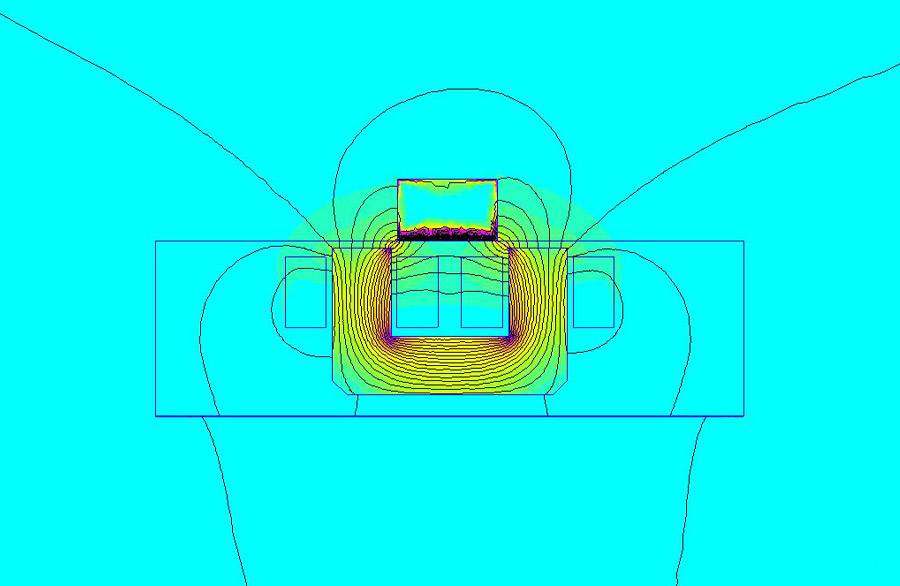
Demagnetisation double yoke
In a demagnetisation double yoke, one yoke is placed below the component and one above. The double yoke demagnetisers are often used for larger components or parts in product carriers due to the height adjustment option.
Advantages
- high field strength close to the pole plates (approx. 40 to >100 kA/m)
- high continuous throughput
Disadvantages
- homogeneous field only for flat plates and components with the same height
- height adjustment is required close to the workpiece
- field stops after the effective range is left
- demagnetisation effect depends on the component’s movement
- normally no one hundred percent switch-on duration
- field strength is often insufficient
- only suitable for flat, stepless designs
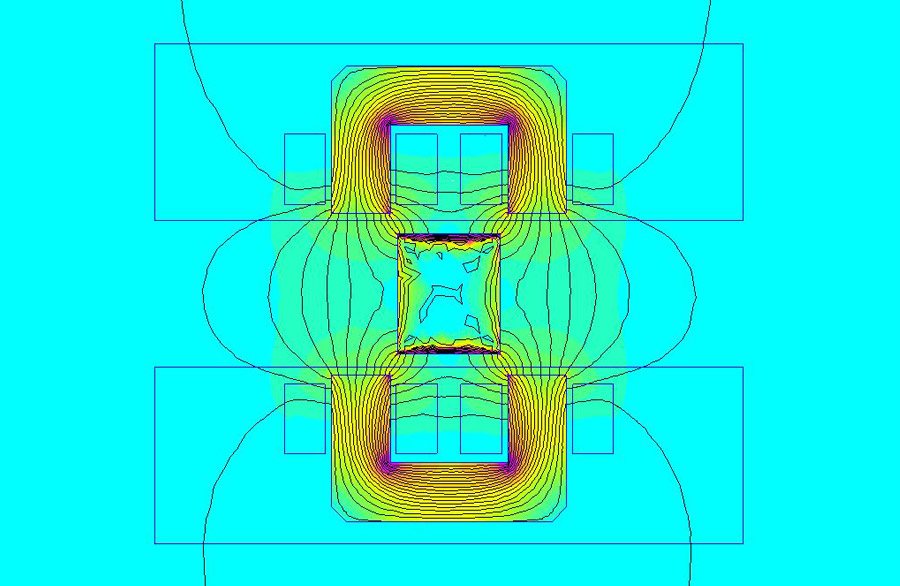
Demagnetising magnets
AlNiCo and ferrite materials can be demagnetised well in the alternating magnetic field. Rare earth magnets cannot be completely demagnetised using this method.
In order to demagnetise permanent magnets, a magnetic field with very high field strength is required, as magnets are made of magnetic materials that have a much higher coercive force (wikipedia/coercive field strength) than iron or steel. After they are manufactured and processed, magnets are magnetised using a very strong magnetic field to up to a 5 Tesla field strength* depending on the magnetic material. On rare earth magnets, the magnetic field of conventional industrial demagnetisation systems is not strong enough to move the magnetic material into the original magnetic state. This is not least due to the strong magnetic anchoring and the magnetisation nucleation.
*Samarium Cobalt 2/17
AlNiCo
The magnetic material that is easiest to demagnetise. With field strengths from 350 kA/m, complete demagnetisation of these materials can be obtained without detriment to the magnetic properties.
Hard ferrite
Hard ferrite magnets are best demagnetised in an oven at over 450 °C. Furthermore, they can be demagnetised well using a powerful demagnetisation system and corresponding flow concentrations if required. Field strengths of over 800 kA/m are required for this. The original condition is obtained except for low residual magnetic fields.
The remaining magnetic nuclei cause higher field strengths to be required for re-magnetisation than for magnets that have been demagnetised in the oven.
No detriment to the magnetic properties is to be expected.
Plasto-ferrite
Plasto-ferrites do not contain enough heat-resistant plastics and binding agents, which prevents demagnetisation in the oven. The only option is powerful demagnetisers.
No detriment to the magnetic properties is to be expected.
Neodymium
Neodymium magnets can also be demagnetised with difficulty using a very strong magnetic field. Demagnetisation by heating is easier. However, this weakens the material. After re-magnetising, the original condition is no longer fully attained and the neodymium magnets’ power is reduced by a few percent. Furthermore, these magnet types are normally coated with a typical galvanic coating that is also damaged. Apart from the heating effect, the knockdown method can also be used.
Samarium Cobalt
Behaves similarly to neodymium magnets. The material is very brittle but does not require any coating due to its corrosion resistance. Therefore, demagnetising in the oven is the preferred method, as alternating field demagnetisation would require very high field strengths of more than 4,000 kA/m. Complete demagnetisation would also not be possible due to the nucleus formation. The material also loses a few percent of its magnetic properties during demagnetisation using heat here.

